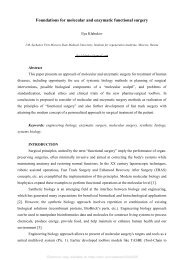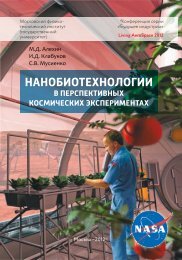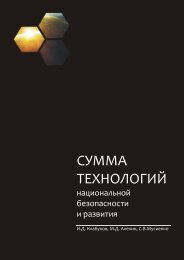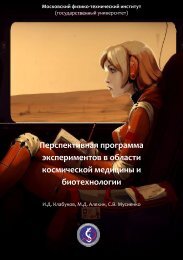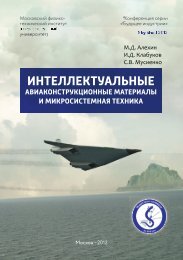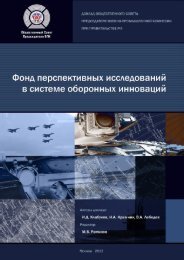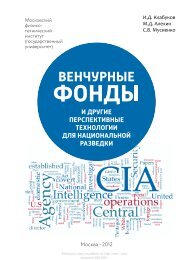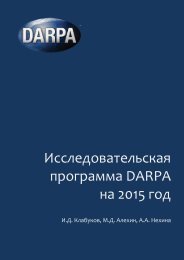Engineering Biology Problems Book (2021, Obninsk Edition)
Create successful ePaper yourself
Turn your PDF publications into a flip-book with our unique Google optimized e-Paper software.
2.5 Peripheral equipment. According to one of the theories, tumors played a significant role in
evolution, being a proto-organ in animals. Suggest a way to design new organs for humans (bio
extensions) consisting of tumors and/or parasites. Possible functions may include infection filtration,
essential amino acid synthesis, etc.
SOLUTION:
Design and assembly would be facilitated with the previously developed Bioconstructor toolkit.
2.6 Bait receptors. Fas receptors and Fas ligands mediate cancer cells elimination by T-killer cells.
Investigation of 35 lung and colon tumors revealed that half of the tumors activated the expression of
the FasL-binding secretable protein. Why and how the overexpression of this protein could further the
survival of the tumors?
© John Wilson, Tim Hunt. Molecular Biology of the Cell 6E - The Problems Book, 2015. (pr. 18-24)
SOLUTION:
Overexpression of a secretable protein, which binds FasL, protects tumor cells from T-killer attacks.
Upon binding, the mentioned protein prevents the interaction of FasL and tumor Fas receptors, thus
isolating the tumor cells from the deadly T-killer cells. Secreted proteins are known as decoy
receptors, and play a significant role in the modulation of Fas-dependent cytolysis. The
overproduction of decoy receptors allows the tumor cells to escape immune-cytotoxic attacks by
blocking FasL [30].
[30. Pitti RM, Marsters SA, Lawrence DA, Roy M, Kischkel FC, Dowd P, Huang A, Donahue CJ,
Sherwood SW, Baldwin DT, Godowski PJ, Wood WI, Gurney AL, Hillan KJ, Cohen RL, Goddard
AD, Botstein D & Ashkenazi A (1998) Genomic amplification of a decoy receptor for Fas ligand in
lung and colon cancer. Nature 396, 699–703.]
2.7 Immune engineering Suggest a method to engineer the immune system for complex peripheral
bio extensions compatibility, including cells of xenogeneic origin.
SOLUTION:
Possible solutions may include a way to select and genetically alter the immune cells, and
immunotolerance training on donor tissues. More radical methods could involve the transplantation of
complex bone marrow grafts to provide induced mixed chimerism [31].
[31. Sykes, M., Preffer, F., McAfee, S., Saidman, S. L., Weymouth, D., Andrews, D. M., ... & Spitzer,
T. R. (1999). Mixed lymphohaemopoietic chimerism and graft-versus-lymphoma effects after
non-myeloablative therapy and HLA-mismatched bone-marrow transplantation. The Lancet,
353(9166), 1755-1759.]
2.8 Parent multiplicity. In 2013, transplantation of donor mitochondria into blastomeres was
approved in GB. This kind of operation is necessary when both parents are diagnosed with hereditary
mitochondrial diseases (e.g. Bart syndrome, Kerns-Sayre syndrome, Pearson syndrome, etc.) Such
egg manipulations have practically allowed for a donor woman to be a third parent. However, there
exist other forms of inheriting, such as microRNAs and egg cytoplasmic protein profiles, which affect
the offspring. A cytoplasm transplant may serve as a way of treatment, which has the effect of
changing the history of a parent (eliminating the consequences of working at hazardous production
facilities, emergency sites, or hunger).
Propose possibilities of using cytoplasm transplantation for preventing the development of certain
diseases.
SOLUTION:
The method could be used when using EF if parental biomaterial contains abnormal non-coding RNA
concentrations.
2.9 Bioethics limits. Nowadays ethical concerns limit the administration of certain drugs, which,
despite being proven effective on a patient’s cell culture, have not passed costly clinical studies. This
principle leads to the illegality of usage of the already available preparations. How bioethical concerns
could be surmounted with the help of new technology?





